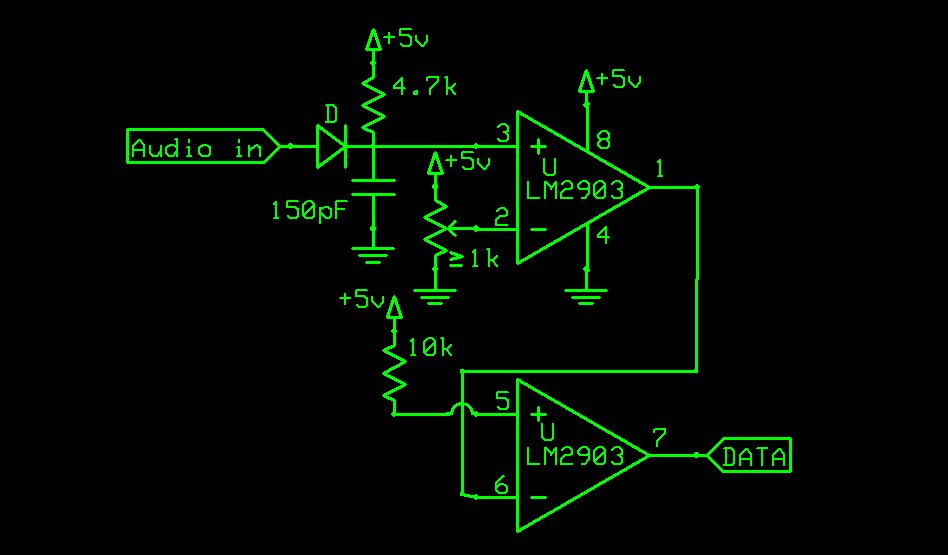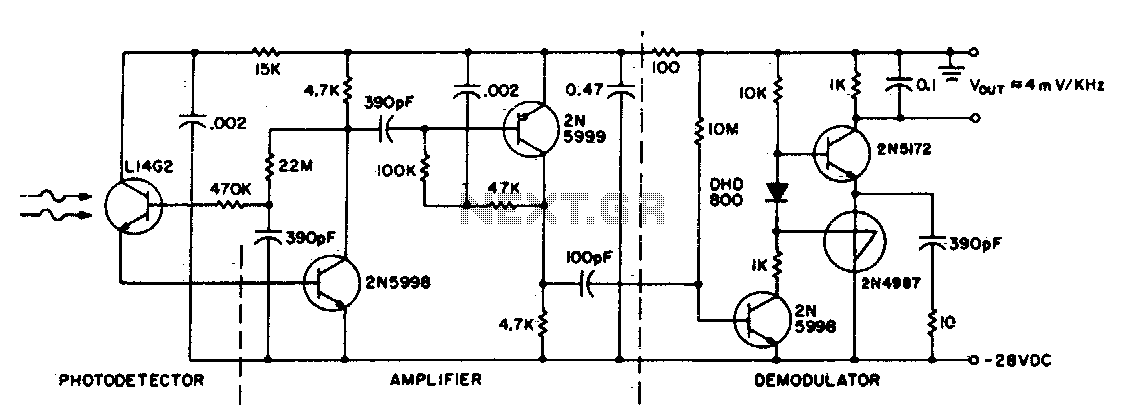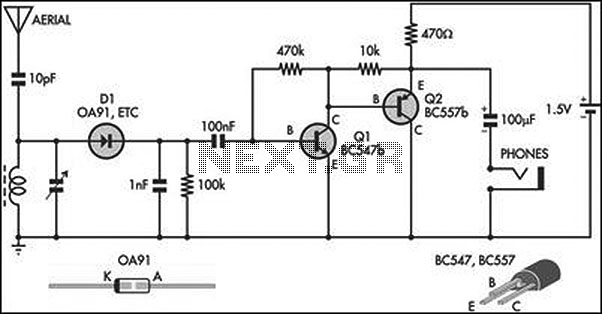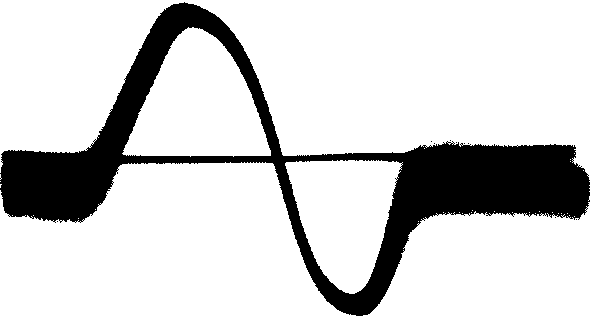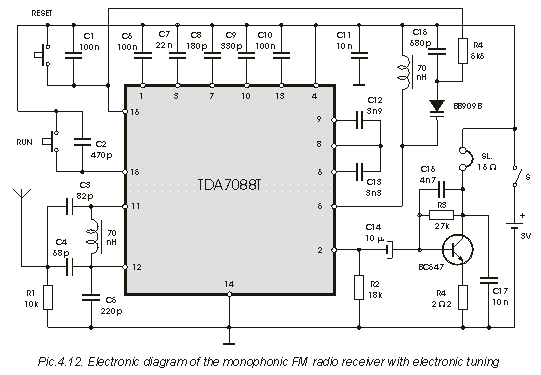
A Regenerative Receiver with AGC for 80 and 40 Meters
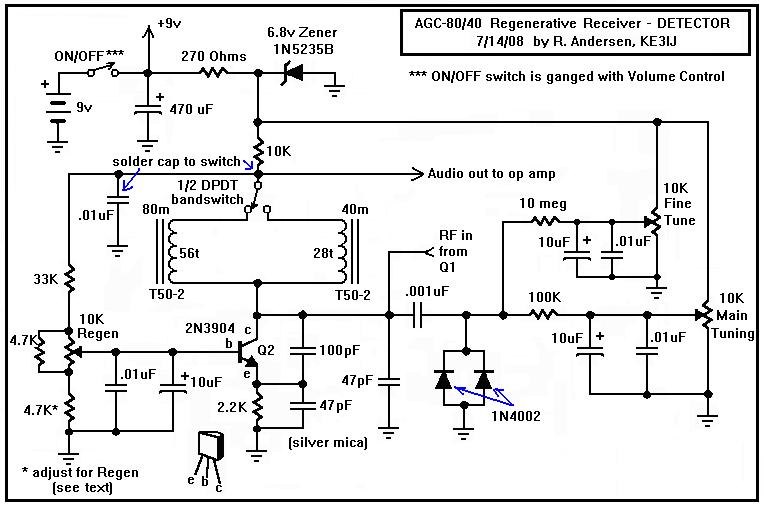
Here is a dual-band regenerative receiver that originated from encouraging communications with Jerry (K9UT) and another individual named Harvey, who constructed the original AGC-80 and its experimental successor, the AGC-80/30. Jerry has expressed his satisfaction with both receivers, noting their surprisingly effective performance despite their simplicity. Several other amateur radio operators have also provided positive feedback regarding the AGC-80. In response to Jerry's inquiry about designing an AGC-controlled regenerative receiver for the 40-meter band, this project, the AGC-80/40, was initiated. This receiver is a successor to the original AGC-80 and employs a Colpitts-based regenerative design with audio-derived Automatic Gain Control (AGC) to mitigate strong signals that may interfere with the detector's performance. Similar to its predecessor, the AGC-80/40 utilizes varactor tuning (using rectifier diodes as varactors) and eliminates the need for bulky, expensive variable capacitors. The previous AGC-80 model included a PCB-mounted trimmer capacitor for calibration, which is no longer present in this new design. Band switching is achieved through a double-pole, double-throw toggle switch that adjusts capacitance values in the front end and switches coils in the regenerative detector stage for operation on both 80 and 40 meters. The receiver incorporates passive filtering with adjustable capacitance values to eliminate extreme high frequencies, utilizing a 2500 Hz low-pass filter for voice transmissions and an 800 Hz peaked low-pass filter for CW transmissions. Although an internal audio amplifier and speaker could be incorporated in the future, the current design routes audio to a front-panel jack for connection to an external amplified speaker. The following section provides a detailed overview of the AGC-80/40 circuitry, housed in a compact metal enclosure manufactured by Hammond. Radio signals entering through the BNC jack are first passed through a 1 kΩ resistor to ground, which serves to dissipate any static charges that may be present on the antenna. With a 50-ohm input impedance, this resistor does not affect the normal operation of the circuit. The front-end pre-selector is a straightforward series L-C circuit consisting of an Amidon T50-2 toroid core with 40 turns of #28 enameled copper wire (approximately 7.4 microhenries) and a 68 pF silver mica capacitor for the 40-meter band (7.0 - 7.3 MHz). This design has been revised from an earlier configuration that utilized a three-winding antenna transformer, reverting to the series L-C approach found in the original AGC-80, which proved to be more effective. When switching from 40 meters to 80 meters, an additional 220 pF capacitor is connected in parallel with the 68 pF capacitor, resulting in a total capacitance of 288 pF and lowering the resonant frequency to the 80-meter band (3.5 - 4.0 MHz). This simple preselector and band switching configuration is optimized for a 50-ohm antenna, and a resonant antenna tuner is employed to achieve impedance matching and additional bandpass filtering. The design intentionally avoids the use of variable capacitors, opting instead for a switched-capacitor method facilitated by the DPDT switch.
The AGC-80/40 receiver's design emphasizes simplicity and effectiveness in its operation. The use of varactor tuning through rectifier diodes not only reduces component count but also enhances reliability by minimizing mechanical wear associated with traditional variable capacitors. The implementation of Automatic Gain Control ensures stable reception across varying signal strengths, which is particularly beneficial in amateur radio applications where signal conditions can fluctuate significantly.
The passive filtering stages contribute to the overall audio quality, allowing for clear voice communication and effective CW reception. The choice of low-pass filter frequencies is carefully considered to accommodate the typical bandwidth requirements of voice and CW signals, ensuring that the receiver remains versatile in its applications.
In summary, the AGC-80/40 represents a thoughtful evolution of the AGC-80 design, maintaining a commitment to simplicity while incorporating advanced features such as AGC and switched-capacitor tuning. The careful selection of components and design choices reflects a deep understanding of radio frequency principles, making this receiver an excellent choice for amateur radio enthusiasts seeking a reliable and effective regenerative receiver for the 40 and 80-meter bands.Here`s a dual-band Regen that came from some encouraging emails from Jerry (K9UT) and another gentleman named Harvey, who built my original AGC-80, and its experimental "Regenerodyne" successor, the AGC-80/30. Jerry and I have corresponded on several occasions, and he tells me that he enjoys both receivers and that they work surprisingly well for
such simple circuits. A few other Hams have written to express their satisfaction with the AGC-80 as well. Many thanks to those of you who gave me helpful feedback. Jerry asked me when I was going to design an AGC-controlled Regen for 40 meters. I pointed out that I had already posted two other 40 meter receivers at my webpage, but neither has AGC. So Jerry`s request led to this project, the AGC-80/40. This is a successor to the original AGC-80, a Colpitts-based Regenerative receiver with audio-derived AGC [Automatic Gain Control] to prevent strong signals from "pulling" or "blocking" the detector.
Like its predecessor, it is `varactor`-tuned [actually I use rectifier diodes as varactors] and has no bulky, expensive variable capacitors. Actually, the AGC-80 did have a pcb-mounted trimmer cap that calibrated the front panel, setting the band limits.
This new receiver does away even with that trimmer cap. Bandswitching is accomplished by a double-pole, double throw toggle switch that switches capacitance values in the "front end" where the signal comes in from the antenna, and simultaneously switches coils (wound on small toroid cores) in the Regen Detector stage, for 80 and 40 meter operation. The receiver also uses passive filtering with switched capacitance values to kill the extreme highs with a 2500 Hz lowpass filter for voice transmissions, or an 800 Hz peaked lowpass filter for receiving CW transmissions.
I probably should have - and may in the future, if I decide to sell this receiver as a kit - add an internal audio amp and speaker; right now, I route the audio to a front-panel jack and into my trusty old Radio Shack Amplified Speaker (see the photos in the AGC-80 article). The following is an in-depth description of the AGC-80/40 circuitry, which I installed in a nice little metal box made by Hammond; see photos near the end of this article.
Radio signals present at the BNC jack (see Front End schematic, below) are brought into the receiver front end across a 1Kohm resistor whose job is simply to dissipate any static charges, that might be present on the antenna, to ground. Since the impedance looking into the front end of the receiver is 50 ohms, this 1K is "invisible" to the normal functioning of the circuit.
The front-end "Pre-selector" is a simple series L-C circuit consisting of L1, an Amidon T50-2 red-gray toroid core wound with 40 turns of #28 enamelled copper "magnet" wire (sold by Radio Shack) and having an inductance of about 7. 4 microhenries, and a 68pF silver mica capacitor, for the 40 meter band [7. 0 - 7. 3 MHz]. [This is a revision; the first release of this receiver on 7/14/08 had a 3-winding antenna transformer, but I found that going back to the same series L-C that I used in the original AGC-80, worked better in this receiver too.
] When the bandswitch is flipped from 40m to 80m, another 220 pF of capacitance is connected in parallel with the 68 pF cap, increasing the total capacitance to 288 pF and lowering the circuit`s resonant frequency to the 80 meter band [3. 5 - 4. 0 MHz]. This is a very simple preselect and bandswitching arrangement that works best with a 50 ohm antenna. I use a `resonant` antenna tuner to accomplish impedance matching and to get some extra "preselect" bandpass filtering via the tuner.
Originally, I was going to have a tuneable "preselector" up front, like the one on my old Drake 2B commercial receiver - but I wanted to stay true to my goal of having NO variable capacitors anywhere in the radio. So I went with the switched-capacitor method which required the use of a DP 🔗 External reference
The AGC-80/40 receiver's design emphasizes simplicity and effectiveness in its operation. The use of varactor tuning through rectifier diodes not only reduces component count but also enhances reliability by minimizing mechanical wear associated with traditional variable capacitors. The implementation of Automatic Gain Control ensures stable reception across varying signal strengths, which is particularly beneficial in amateur radio applications where signal conditions can fluctuate significantly.
The passive filtering stages contribute to the overall audio quality, allowing for clear voice communication and effective CW reception. The choice of low-pass filter frequencies is carefully considered to accommodate the typical bandwidth requirements of voice and CW signals, ensuring that the receiver remains versatile in its applications.
In summary, the AGC-80/40 represents a thoughtful evolution of the AGC-80 design, maintaining a commitment to simplicity while incorporating advanced features such as AGC and switched-capacitor tuning. The careful selection of components and design choices reflects a deep understanding of radio frequency principles, making this receiver an excellent choice for amateur radio enthusiasts seeking a reliable and effective regenerative receiver for the 40 and 80-meter bands.Here`s a dual-band Regen that came from some encouraging emails from Jerry (K9UT) and another gentleman named Harvey, who built my original AGC-80, and its experimental "Regenerodyne" successor, the AGC-80/30. Jerry and I have corresponded on several occasions, and he tells me that he enjoys both receivers and that they work surprisingly well for
such simple circuits. A few other Hams have written to express their satisfaction with the AGC-80 as well. Many thanks to those of you who gave me helpful feedback. Jerry asked me when I was going to design an AGC-controlled Regen for 40 meters. I pointed out that I had already posted two other 40 meter receivers at my webpage, but neither has AGC. So Jerry`s request led to this project, the AGC-80/40. This is a successor to the original AGC-80, a Colpitts-based Regenerative receiver with audio-derived AGC [Automatic Gain Control] to prevent strong signals from "pulling" or "blocking" the detector.
Like its predecessor, it is `varactor`-tuned [actually I use rectifier diodes as varactors] and has no bulky, expensive variable capacitors. Actually, the AGC-80 did have a pcb-mounted trimmer cap that calibrated the front panel, setting the band limits.
This new receiver does away even with that trimmer cap. Bandswitching is accomplished by a double-pole, double throw toggle switch that switches capacitance values in the "front end" where the signal comes in from the antenna, and simultaneously switches coils (wound on small toroid cores) in the Regen Detector stage, for 80 and 40 meter operation. The receiver also uses passive filtering with switched capacitance values to kill the extreme highs with a 2500 Hz lowpass filter for voice transmissions, or an 800 Hz peaked lowpass filter for receiving CW transmissions.
I probably should have - and may in the future, if I decide to sell this receiver as a kit - add an internal audio amp and speaker; right now, I route the audio to a front-panel jack and into my trusty old Radio Shack Amplified Speaker (see the photos in the AGC-80 article). The following is an in-depth description of the AGC-80/40 circuitry, which I installed in a nice little metal box made by Hammond; see photos near the end of this article.
Radio signals present at the BNC jack (see Front End schematic, below) are brought into the receiver front end across a 1Kohm resistor whose job is simply to dissipate any static charges, that might be present on the antenna, to ground. Since the impedance looking into the front end of the receiver is 50 ohms, this 1K is "invisible" to the normal functioning of the circuit.
The front-end "Pre-selector" is a simple series L-C circuit consisting of L1, an Amidon T50-2 red-gray toroid core wound with 40 turns of #28 enamelled copper "magnet" wire (sold by Radio Shack) and having an inductance of about 7. 4 microhenries, and a 68pF silver mica capacitor, for the 40 meter band [7. 0 - 7. 3 MHz]. [This is a revision; the first release of this receiver on 7/14/08 had a 3-winding antenna transformer, but I found that going back to the same series L-C that I used in the original AGC-80, worked better in this receiver too.
] When the bandswitch is flipped from 40m to 80m, another 220 pF of capacitance is connected in parallel with the 68 pF cap, increasing the total capacitance to 288 pF and lowering the circuit`s resonant frequency to the 80 meter band [3. 5 - 4. 0 MHz]. This is a very simple preselect and bandswitching arrangement that works best with a 50 ohm antenna. I use a `resonant` antenna tuner to accomplish impedance matching and to get some extra "preselect" bandpass filtering via the tuner.
Originally, I was going to have a tuneable "preselector" up front, like the one on my old Drake 2B commercial receiver - but I wanted to stay true to my goal of having NO variable capacitors anywhere in the radio. So I went with the switched-capacitor method which required the use of a DP 🔗 External reference
